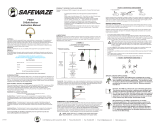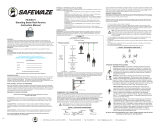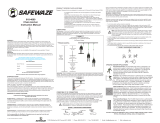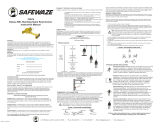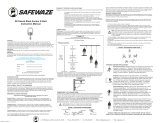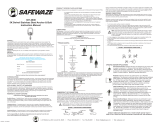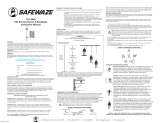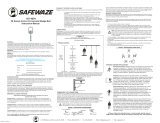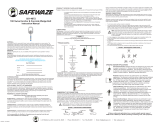Page is loading ...

225 Wilshire Ave SW, Concord NC, 28025 Phone: 800-230-0319 Email: [email protected] Web: safewaze.com Fax: 704-262-9051
II I I I
FS871 / FS871N / FS871-25 (Pack of 25)
Knock-Down Roof Anchor
OSHA 1926 Subpart M, ANSI Z359.1
This manual is intended to meet the manufacturer’s instructions as required by
ANSI Z359 and should be used as part of an employee training program as required
by OSHA.
WARNING
This product is part of a personal fall arrest, work positioning, suspension or rescue system. The
manufacturer’s instructions must be provided to users of this equipment. The user must follow the
manufacturer’s instructions for each component of the system. The user must read and understand these
instructions before using this equipment. Manufacturer’s instructions must be followed for proper use
and maintenance of this equipment. Alterations to this product, misuse of this product, or failure to follow
instructions may result in serious injury or death.
IMPORTANT
Questions regarding the use, care, or suitability of this equipment for your application? Contact
Safewaze.
IMPORTANT
Record identication information before using this product. Identication information may be found on
the equipment label. This information should be recorded in the “Inspection Log” located at the back of
this manual
Do not throw away these instructions!
Read and understand these instructions before using equipment!
User Information
Date of First Use:
Serial#:
Trainer:
User:
INTRODUCTION
Thank you for purchasing a Safewaze Anchorage Connector. This manual must be read and understood
in its entirety, and used as part of an employee training program as required by OSHA or any applicable
state agency. This manual and any other instructional material must be available to the user of the
equipment. The user must understand how to safely and eectively use these anchors, and all fall
protection equipment used in conjuction with the anchor.
APPLICABLE SAFETY STANDARDS
When used according to instructions, SafeWaze Anchors meet all applicable ANSI Z359.1 standards
and OSHA regulations for fall protection. Applicable standards and regulations depend on the type of
work being done, and may include state-specic regulations. Refer to local, state, and federal (OSHA)
requirements for additional information concerning the governing of occupational safety
regarding Personal Fall Arrest Systems (PFAS).
WORKER CLASSIFICATIONS
Understand the denitions of those who work in proximity of or may be
exposed to fall hazards.
PRODUCT SPECIFIC APPLICATIONS
Lanyard Length
(6’ Total)
Deceleration
distance (3.5’ total)
Height of harness dorsal
D-ring from
worker’s feet
(6’ total)
Safety factor
(2’ total)
Required
distance
from
Anchorage
(17.5’ total)
Fall Clearance: There must be sucient clearance below the anchorage connector to arrest a fall
before the user strikes the ground or an obstruction. When calculating fall clearance, account for a
MINIMUM 2’ safety factor, deceleration distance, user height, length of lanyard/SRL, and all other
applicable factors. (See Figure 1)
LIMITATIONS
Fall Clearance Diagram
***Diagram shown is an example
fall clearance calculation ONLY.
For all applications: worker weight capacity range
(including all clothing, tools, and equipment) is 130-310 lbs
FIGURE 1
Swing Falls: Prior to installation or use, make considerations for eliminating or minimizing all swing
fall hazards. Swing falls occur when the anchor is not directly above the location where a fall occurs.
Always work as close to in line with the anchor point as possible. Swing falls signicantly increase
the likelihood of serious injury or death in the event of a fall. (See Figure 2)
COMPATIBILITY OF CONNECTORS
Connectors are compatible with connecting elements when they have been designed to work together
in such a way that their sizes and shapes do not cause their gate mechanisms to inadvertently open
regardless of how they become oriented. Connectors (hooks, carabiners, and D-rings) must be
capable of supporting at least 5,000 lbs. (22.2 kN). Connectors must be compatible with the anchorage
or other system components (see Figure 4). Do not use equipment that is not compatible.
Non-compatible connectors may unintentionally disengage (see Figure 3). Connectors must be
compatible in size, shape, and strength. Self-locking snap hooks and carabiners are required by ANSI
Z359 and OSHA guidelines. Contact Safewaze if you have any questions about compatibility.
FIGURE 3 - UNINTENTIONAL DISENGAGEMENT
3 - Gate opens
2 - Gate presses
against
non-compliant
part
4 - And parts
disengage.
1 - Non Compliant Part
NOTE: SOME SPECIALITY CONNECTORS HAVE ADDITIONAL
REQUIREMENTS. CONTACT SAFEWAZE WITH QUESTIONS.
FIGURE 2
MAKING CONNECTIONS
Snap hooks and carabiners used with this equipment must be double locking and/or twist lock. Ensure
all connections are compatible in size, shape and strength. Do not use equipment that is not compatible.
Ensure all connectors are fully closed and locked.
Safewaze connectors (snap hooks and carabiners) are designed to be used only as specied in each
product’s user’s instructions. See gure 4 for examples of inappropriate connections. Do not connect
snap hooks and carabiners:
• To a D-ring to which another connector is attached.
• In a manner that would result in a load on the gate (with the exception of tie back hooks). NOTE:
Large snap hooks must not be connected to objects which will result in a load on the gate if the hook
twists or rotates. Snap hooks marked with ANSI Z359.12 and are equipped with a 3,600 lb (16 kN)
gate. Check the marking on your snap hook to verify its compatibility.
NOTE: Large throat snap hooks must not be connected to standard size D-rings or similar
objects which will result in a load on the gate if the hook or D-ring twists or rotates, unless
the snap hook complies with ANSI Z359.1-2007 or ANSI Z359.12 and is equipped with a
3,600 lb (16 kN) gate. Check the marking on your snap hook to verify that it is appropriate
for your application.
• In a false engagement, where features that protrude from the snap hook or carabiner catch on the
anchor, and without visual conrmation seems to be fully engaged to the anchor point.
• To each other.
• By wrapping the web lifeline around an anchor and securing to lifeline except as allowed for Tie Back
models.
• To any object which is shaped or sized in a way that the snap hook or carabiner will not close and
lock, or that roll-out could occur.
• In a manner that does not allow the connector to align properly while under load.
Using a connector that is undersized or irregular in shape (1) to connect a snap hook or carabiner could
allow the connector to force open the gate of the snap hook or carabiner. When force is applied, the gate
of the hook or carabiner presses against the non-compliant part (2) and forces open the gate (3). This
allows the snap hook or carabiner to disengage (4) from the connection point.
FS871 Manual - 220-00019
SPECIFIC ANCHOR APPLICATIONS
Personal Fall Arrest: Safewaze Anchors are designed as an anchor point
to support a maximum of 1 Personal Fall Arrest System (PFAS) when
utilized for fall protection applications. The structure to which the anchor
is attached must withstand loads applied in the directions permitted by the
system of at least 5,000 lbs. Maximum allowable free fall is 6’.
Restraint: Safewaze Anchors are authorized for use in Restraint
applications. The structure to which the anchor is attached must withstand
loads applied in the directions permitted by the system of at least 1,000
lbs NO free fall is permitted. Restraint systems may only be used on
surfaces with slopes up to 4 / 12 (vertical / horizontal). For Restraint
applications, the allowable attachment points to harness are Dorsal
D-ring, Chest D-ring, Side D-rings, and Shoulder D-rings.
Work Positioning: Safewaze Anchors are authorized for use in Work
Positioning applications. Work Positioning allows a worker to be
supported during suspension while freeing both hands to conduct work
operations. The structure to which the Anchor is attached must
withstand loads applied in the directions permitted by the system of at
least 3,000 lbs. Maximum allowable free fall is 2’. For positioning
applications, the allowable attachment points to harness are the Side
D-rings.
Rescue/Conned Space: Safewaze Anchors are authorized for use in
Rescue/Conned Space applications. Rescue systems are utilized to
safely recover a worker from a conned location or after exposure to a fall.
Composition of rescue systems can vary based upon the type of rescue
involved. The structure to which the Anchor is attached must withstand
loads applied in the directions permitted by the system of at least 3,000
lbs. NO free fall is permitted. For rescue applications, the allowable
attachment points to harness are Dorsal D-ring, Chest D-ring and
Shoulder D-rings.
A
FALL-ARREST
S
W
I
N
G
F
A
L
L
FIGURE 4 - INAPPROPRIATE CONNECTIONS
Qualied Person: “Qualied Person” means one who, by possession of a recognized degree,
certicate, or professional standing, or who by extensive knowledge, training, and experience, has
successfully demonstrated his ability to solve or resolve problems relating to the subject matter, the
work, or the project.
Competent Person: “Competent Person” means one who is capable of identifying existing and
predictable hazards in the surroundings or working conditions which are unsanitary, hazardous, or
dangerous to employees, and who has authorization to take prompt corrective measures to eliminate
them.
Authorized Person: “Authorized Person” means a person approved or assigned by the employer to
perform a specic type of duty or duties or to be at a specic location or locations at the job site.
It is the responsibility of a Qualied or Competent person to supervise the job site and
ensure safety regulations are complied with.
Purpose: Safewaze Anchors are designed to be used as part of a Personal Fall Arrest System (PFAS).
- A competent person shall train users on this equipment in accordance with OSHA
and ANSI.
- Never exceed a free fall distance of 6 ft. A free fall of more than 6 ft could cause
excessive arrest forces that could result in serious injury or death.
- Safewaze Anchors have a maximum capacity of 310 lbs. (141 kg)
including any tools, clothing, accessories, etc..., unless otherwise rated by Safewaze.
- Structures for attachment of Safewaze Anchors shall support a minimum 5,000 lbs or
be designed with a safety factor of two by a Qualied Person.
- All Safewaze anchors must IMMEDIATELY be removed from service if subjected
to fall arrest forces.
- Safewaze anchors shall be inspected by the end user prior to each usage and
by a Competent Person other than the user at least annually. These inspections
shall be documented.
All above referenced applications have a worker weight capacity range of
310 lbs(including all clothing, tools, and equipment).

225 Wilshire Ave SW, Concord NC, 28025 Phone: 800-230-0319 Email: [email protected] Web: safewaze.com Fax: 704-262-9051
II I I I
NO NO
30° 30°
INSTALLATION
INSTALLATION
REMOVAL
FS871-25
FS871 ANCHOR COMPONENTS FS871N ANCHOR COMPONENTS WARNING
• Users should consult with their doctor to verify ability to safely absorb the forces of a fall arrest event.
Fitness level, age, and other health conditions can greatly aect an individuals ability to withstand fall
arrest forces. Women who are pregnant, individuals considered minors must not use any Safewaze
equipment.
• Never alter any part of an anchor or add/remove components. Safewaze shall not be held
responsible for injury or death due to tampering.
• Anchors that are exposed to fall arrest forces MUST be IMMEDIATELY removed from service and
destroyed.
• Failure to follow these instructions and warnings could result in serious injury or death in the event
of a fall.
• A preplanned rescue procedure in the event of a fall is required. The rescue plan must be specic
to the project. The rescue plan must allow for employees to rescue themselves, or to be promptly
rescued by alternative means.
• Harnesses or connectors selected for use with any Safewaze anchor must be compatible in size and
conguration. User must ensure compatibility of snap hooks, carabiners and other connectors. Any
connection which could allow disengagement must be eliminated. Snap hooks and carabiners must
be self locking and self closing and must never be hooked to each other.
• A Competent Person must conduct an analysis of the workplace and anticipate where workers will
be conducting their duties, the route they will take to reach their work, and the existing and potential
fall hazards they may be exposed to. The Competent Person must choose the fall protection
equipment to be utilized.
• Do not misuse equipment.
• Equipment designated for fall protection must never be used to lift, hang, support or hoist tools or
equipment unless specically certied for such use.
• Safewaze Anchors shall be inspected prior to each use by the user, and at least annually by a
Competent Person other than the user. Annual inspections shall be documented. Severity of
conditions during use may necessitate increased frequency of documented inspections.
• Anchors that fail inspection MUST be removed from service.
• Prior to each use, inspect the anchor for deciencies or damage, including, but not limited to, sharp
edges, rough edges, deformations, corrosion, pits, burrs, chemical exposure, extreme heat
exposure, kinked, bird nested, or otherwise damaged cable, and damaged, missing or illegible
labels. If any deciencies or defects are found, the anchor must IMMEDIATELY be removed from
service.
• The anchor must be inspected at least annually by a Competent Person other than the user.
• Competent person inspections must be recorded in the inspection log included in this manual and on
the inspection grid label on the anchor.
INSPECTION
MAINTENANCE & STORAGE
WARRANTY
Anchor can be cleaned with water and mild soap if necessary. User should remove all dirt, possible
corrosives, and contaminants from the anchor prior to, and after each use. Never use any type of
corrosive substance to clean the anchor.
Excess water should be blown out with compressed air. Hardware can be wiped o with a clean, dry
cloth.
When not in use, store the anchor in a cool dry area where it will not be exposed to extreme light,
extreme heat, excessive moisture, or possibly corrosive chemicals or materials.
Safewaze warrants its products are free from defects in materials and construction under normal use
and service. Liability is not accepted for abuse, modication, improper use, destructive activity and
contaminated exposure.
INSPECTION LOG
Date Inspection Items
Noted
Corrective Action Initials
LABELS
The FS871/871N can be removed in it’s entirety if no longer needed, or the user can simply hammer
the fall protection connection point of the anchor at and shingle over. The user can also snap o and
remove the fall connection point as well.
Installation and use of the FS871 will damage the substrate to which it is installed. The user is
responsible for eective repair of the roof area where install occurred.
1. The FS871 is installed over and into a roof truss at the peak of the rooine.
2. The work location should be free of debris, and other materials or equipment that could
interfere with the proper installation or operation of this equipment.
3. Inspect the substrate to which the anchor will be attached. User should inspect for the following
hazards. These hazards include, but are not limited to: rot, cracks, severe weathering, soft or
deteriorated areas in the sheathing, or damage from severe weather. The FS871 must be installed
a minimum of 5’ from any edge.
4. Installation of the FS871 requires that fasteners penetrate both the substrate and the truss.
Substrate must be a minimum of 3/4” CDX plywood. Fasteners must go through the sheathing and
penetrate the truss a minimum of 1-1/2” (See Figure 6, Dwg.1). Do not install or use the FS871 on
either the truss or sheathing independently. Installation must capture both the sheathing and truss.
5. To install with nails, position the anchor over previously secured roof sheathing (do not attach directly
to the rafter or truss member). The roof anchor must be placed with the holes lined up directly over a
framing member. Drive the nails into the holes on both plates, through the sheathing, and directly
into framing member. All holes must be used.
6. Ensure all required holes are lled and nails are fully installed (See Figure 7). DO NOT attach a
lifeline between two or more FS871 anchors (i.e, Horizontal Lifeline System).
7. PFAS connecting device can now be connected to the FS871 (See Figure 6, Dwg. 2).
8. User must ensure that he/she works within the allowable work zone to avoid excessive loads on the
FS871. Figure 8 indicates the allowable load conditions for the anchor.
1. The FS871N is installed over and into a roof truss at the peak of the rooine.
2. The work location should be free of debris, and other materials or equipment that could
interfere with the proper installation or operation of this equipment.
3. Inspect the substrate to which the anchor will be attached. User should inspect for the following
hazards. These hazards include, but are not limited to: rot, cracks, severe weathering, soft or
deteriorated areas in the sheathing, or damage from severe weather. The FS87iN must be installed
a minimum of 5’ from any edge.
4. Installation of the FS871N requires that fasteners penetrate both the substrate and the truss.
Substrate must be a minimum of 3/4” CDX plywood. Fasteners must go through the sheathing and
penetrate the truss a minimum of 1-1/2” (See Figure 6, Dwg.1). Do not install or use the FS871N on
either the truss or sheathing independently. Installation must capture both the sheathing and truss.
5. To install with nails, position the anchor over previously secured roof sheathing (do not attach directly
to the rafter or truss member). The roof anchor must be placed with the holes lined up directly over a
framing member. Drive the nails into the holes on both plates, through the sheathing, and directly
into framing member. All holes must be used.
6. Ensure all required holes are lled and nails are fully installed (See Figure 7). DO NOT attach a
lifeline between two or more FS871N anchors (i.e, Horizontal Lifeline System).
7. PFAS connecting device can now be connected to the FS871N (See Figure 6, Dwg. 2).
8. User must ensure that he/she works within the allowable work zone to avoid excessive loads on the
FS871N. Figure 8 indicates the allowable load conditions for the anchor.
FIGURE 5 - ANCHOR COMPONENTS FIGURE 9 - ANCHOR COMPONENTS
FIGURE 7 - NAIL INSTALLATION DIAGRAM FIGURE 8 - ALLOWABLE LOAD CONDITIONS
FIGURE 6 - INSTALLATION
FIGURE 10 - REMOVAL
BB
CC
DD
E
AA
Dwg. 2
Anchor Components
A Fall Protection Connection Point
B Knock Down Seam
C Pre-drilled Fastener Holes
D Anchor Leg
Anchor Components
A Fall Protection Connection Point
B Knock Down Seam
C Pre-drilled Fastener Holes
D Anchor Leg
E (8) 16D Steel Nails
FS871
Knock Down Roof Anchor
FS871N
Knock Down Roof Anchor
Dwg. 1
Installer must use eight (8) 16d 3-1/2 in nails to attach
this anchor through the roof sheathing into a truss or
structural member capable of holding a 5000 lbf load.
If bracket is deformed due to
impact or wear, it must
be destroyed or bent
over and covered by
roofing. This is NOT a
permanent or reusable
anchor. It must be bent
over and destroyed
after use.
Use of a full body harness and a
deceleration device is recommended.
01179R1
225 Wilshire Ave SW, Concord, NC 28025
(800) 230-0319
SINGLE USE ROOF BRACKET
FS871
Material: Zinc plated steel
Maximum working load: 310 lbs
Minimum Breaking Strength: 5000 lbf / 22.25kN
Must follow all mfg’s instructions
included with the equipment. Must be
inspected before each use. Only
make compatible connections. Remove
from service if subjected to fall arrest
forces. Avoid all physical hazards
including, but not limited to, thermal,
electrical and chemical sources.
Do not remove label.
Meets: OSHA 1910.66 & 1926.502;
ANSI Z359.1
www.safewaze.com
J F M A M J J A S O N D
YEAR
MFG. DATE
The FS871 / FS871N can be shaped
by hand to conform to
dierent roof contours.
The FS871 / FS871N can be shaped
by hand to conform to
dierent roof contours.
The FS871-25 is a convenient option for large jobs, or for stock until they are needed. Each FS871-25
contains (25) FS871 anchors. Installation hardware (nails) are not included.
/
